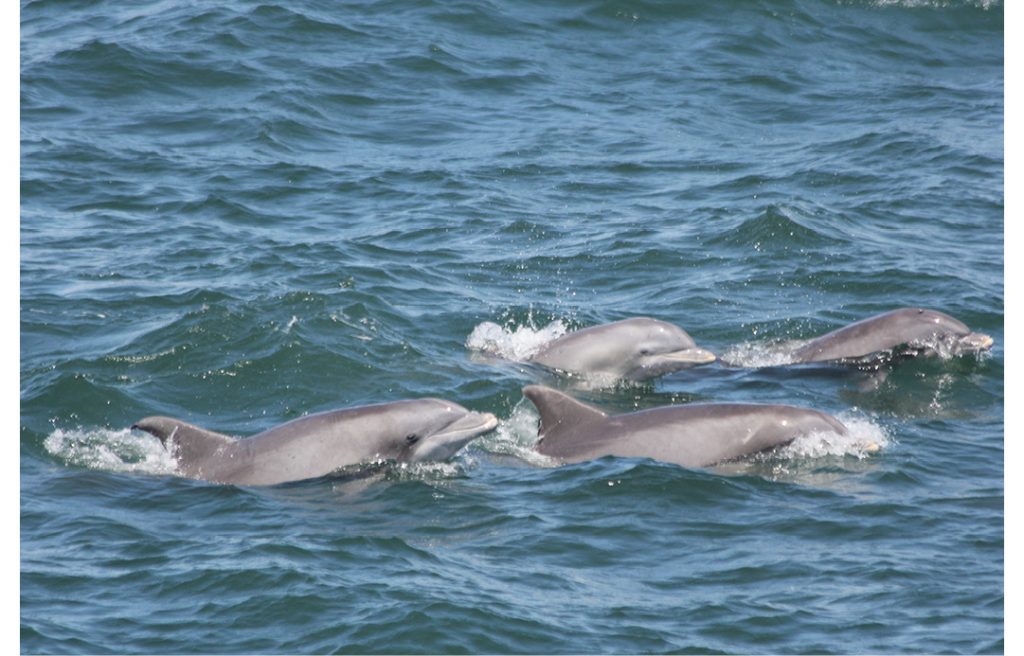By Monica Pepe, Whale and Dolphin Conservation Policy Manager, Conservation and Education
In my many years of whale watching, one of the most consistent reactions I’ve seen from passengers is total excitement from seeing a pod of dolphins. Maybe it’s that they don’t expect to see dolphins on a whale watch so it’s a nice surprise. Maybe it’s because dolphins are more relatable for people – visitors to coastal towns may have seen dolphins swimming in the surf at the beach, or they’ve seen the Flipper TV series. Whatever the reason, it is indeed always a treat to spend time in the company of dolphins in their natural habitat at sea.
In the North Atlantic, there are many different species of dolphins, but three species tend to be seen more commonly. Perhaps the most familiar is the bottlenose dolphin; this species favors temperate and tropical waters, which means you’ll most likely find them in the mid-Atlantic (New York and south). Further north, the commonly seen dolphin species include the Atlantic white-sided dolphin and short-beaked common dolphin. Each of these northern species have multi-colored patterns along their sides, and yes, the Atlantic white-sided dolphins have white on their sides!
A quick disclaimer before diving any deeper: there are many variations in the details that apply to each species and even individuals within a population. Imagine being asked about the favorite food of humans, for example; your answer would have many caveats depending on cultural impacts, geographic location, and what is available to certain populations. In an attempt to provide a short overview on dolphins in the region I’ve made some generalizations that apply in most cases, but please note there are always exceptions. To learn more about a particular species, visit WDC’s species guide from the homepage of our website – whales.org.
The primary diet for most dolphins includes a variety of small schooling fish – things like herring, mackerel, cod, menhaden – and squid and shrimp. Their food typically has to be small enough that they don’t have to break it into tiny pieces to eat. Even though they have teeth, their teeth are all the same cone shape, unlike humans who have teeth of different sizes and shapes. This is because they mostly use their teeth to grab and trap prey rather than chew and grind it like we do.

Bottlenose Dolphins © Cape May Whale Watch & Research Center
For dolphins, meal time involves coordinated hunting efforts with their close-knit social groups, known as pods. These pods include family members and friends who travel together in numbers ranging from a few dozen to a few hundred. In some cases, multiple pods may join up for a short time to form a “superpod,” which may prove beneficial for things like finding prey and mating. Generally speaking, dolphins tend to move throughout smaller ranges in their habitat with seasonal shifts between deeper and shallower water as the water temperature fluctuates.
The primary driver for their movements is food. Where we find dolphins is where the dolphins find food. We are fortunate that this sometimes includes coastal areas where the average boater has a good chance of seeing dolphins going about their day. In these situations, it’s important to be prepared and know the proper ways to maneuver safely around them. There are a few key things to keep in mind:
• Keep a distance of 50 yards from dolphins and put your engine in neutral when dolphins are near. This will allow both you and the dolphins more time to avoid each other in the case of unpredictable movements.
• Refrain from feeding, touching, or swimming with dolphins. If a dolphin starts to associate boats with friendly humans or an all-you-can-eat buffet, it makes them more susceptible to being accidentally hit by a boat or caught up in fishing gear from boats they approach in the future.
• Move away cautiously if dolphins show signs of disturbance. All marine mammals, including dolphins, are protected by federal law which makes it illegal to harass or disturb them. If you see a sudden change in their behavior, it is probably time to move away.
• Let the dolphins decide whether they want to ride your bow or surf in your wake. Approaching them specifically with that intent would disrupt their natural behavior and therefore be illegal.
Following these tips will help you make sure that your boat’s operations on the water don’t alter the natural behavior of dolphins. The best thing you can do is hang back and appreciate your special encounter from a distance! ■
